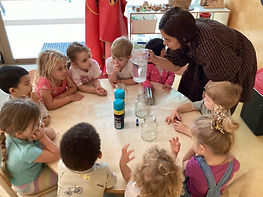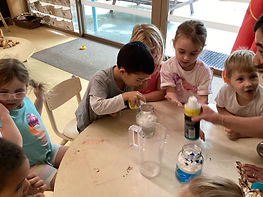Journal and Reflection:
Week 2 (19-23 February 2024)
Exploring Sciene-Magical Plastics Bag Experiment.
Link to:
-
National Quality Standards Q1 Educational Program and Practice
-
Australian Teaching Standards 2.1 Content and teaching strategies of the teaching area
-
Australian Teaching Standards 2.2 Content selection and organisation
-
Australian Teaching Standards 3.2 Plan, structure and sequence learning programs
-
EYLF Learning Outcome 4. Children are confident and involved learners
-
EYLF Learning Outcome 5. Children are effective communicators.
-
Teaching strategies: Sustained shared thinking, intentional teaching
Children participated in an amazing science experiment known as the Magical Plastic Bag Experiment. In this experiment,
we half-filled a zip-up bag with water and carefully closed it. A child held the bag while another carefully poked pencils through it from one side to the other. As the children passed the pencils into the bag, they noticed an apparently supernatural phenomenon: the bag sealed itself around the pencils.
Journal and Reflection: Exploring Science - Magical Plastic Bag Experiment
Children in the preschool room
Journal Entry:
The Magical Plastic Bag Experiment increased the children's curiosity and inspired their interest in science today. As we gathered around the table, nervousness impacted the air as we prepared to carry out the experiment. We closed the zip-up bag tightly after filling it halfway with water, then began pushing pencils through it.
Children were amazed when the bag seemed to seal itself around the pencils, avoiding water leakage. Their faces showed up with surprise and delight as they watched this beautiful occurrence happen in front of them. As the educator, I documented the experience with images, which increased the children's engagement and enjoyment of the exercise.
Throughout the experiment, children actively participated in discussions about what they had observed, demonstrating sustained shared thinking, deliberate teaching, and co-construction. They posed questions, shared their theories, and worked together to make sense of the scientific principles at play.
After finishing the experiment, we took some time to reflect on our findings and explore the science behind the phenomenon. The children eagerly discussed their findings and exhibited their interest in the experiment, exhibiting their confidence and involvement as learners.
Reflection:
The Magical Plastic Bag Experiment enabled children to investigate scientific principles in a hands-on and entertaining manner. The experiment helped children improve their critical thinking, observation skills, and comprehension of scientific fundamentals like surface tension and polymers.
The incorporation of play pedagogy into the experiment enabled structured play, creating a dynamic learning environment in which children felt empowered to investigate and discover scientific phenomena. Educators enabled meaningful interactions and learning experiences by promoting sustained shared thinking, deliberate instruction, and co-construction, fostering children's confidence and involvement as learners.
What Next?
Moving forward, it is critical to continue offering opportunities for children to participate in scientific research and experimentation. By instilling a love of science in children from an early age, we can promote curiosity, creativity, and a lifetime love of learning.
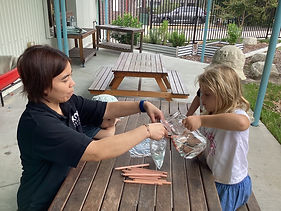
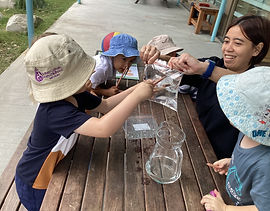


Exploring Chemical Science- Sand Volcano
Link to:
-
National Quality Standards Q1 Educational Program and Practice
-
Australian Teaching Standards 2.1 Content and teaching strategies of the teaching area
-
Australian Teaching Standards 2.2 Content selection and organisation
-
Australian Teaching Standards 3.2 Plan, structure and sequence learning programs
-
EYLF Learning Outcome 4. Children are confident and involved learners
-
EYLF Learning Outcome 5. Children are effective communicators.
-
Teaching strategies: Sustained shared thinking, intentional teaching
Sophia was excited about constructing a sandpit volcano with Micah during outside playing, so today's activity was inspired from that. Inspired by their enthusiasm, I encouraged the children to join in the sandpit for morning playing. As we played and moulded the sand, I saw the children's fascination with volcanoes. To grab their attention, we decided to make a sandpit volcano together. The children happily shaped a volcano out of sand and added a mixture of bicarbonate and vinegar in the centre to represent lava. This hands-on experience presented numerous learning opportunities, including conversations about volcanoes, chemical science experiments, engineering principles, and mathematical concepts like size and quantity.
Journal and Reflection: Sandpit Volcano Experiment
Journal Entry:
Today's sandpit volcano experiment was an exciting and engaging experience for both the children and me. As we gathered in the sandpit, I noticed the children's enthusiasm and curiosity about volcanoes, prompted by Sophia's description of her outdoor play experience. We shaped a volcano from sand together, inspired by their curiosity and ingenuity.
As we added the bicarbonate and vinegar mixture to the volcano, children were excited to see the reaction, staring at the pretend lava that bubbled and flowed. The activity provided several learning possibilities, ranging from conversations about volcanoes and their geographical locations to hands-on experiments with chemical reactions and engineering principles.
Throughout the activity, I used methods of instruction such continuous shared thinking, deliberate teaching, and co-construction to create a dynamic learning environment in which children felt confident and engaged in their learning. By incorporating carefully designed play into the curriculum, we were able to smoothly integrate educational principles with hands-on exploration and discovery.
Reflection:
The sandpit volcano experiment offered children an excellent opportunity to engage in transdisciplinary learning and discovery. By following the children's interests and expanding their play experiences, we were able to introduce complicated scientific topics in a pleasant and approachable manner. Moving forward, it is critical to expand on this experience by investigating different chemicals that react, mix, or dissolve, researching various types of volcanoes through literature and digital media, and developing methods to create waterways in the sandpit, such as adding pipes and measuring their lengths.
By including play paedagogy and play into our curriculum, we may help children gain important skills and knowledge while also cultivating their natural curiosity and love of learning. Today's sandpit volcanic experiment was just the start of our voyage of enquiry and discovery, and I'm looking forward to the many wonderful learning possibilities that await us.
What Next?
Following the Sandpit Volcano Experiment, a recommended activity to further engage children in science exploration is a learning process into various sorts of rocks and minerals. This exercise would allow children to investigate the qualities of rocks and minerals, learn about their formation, and practice hands-on identification and categorisation.
Rocks and Minerals Exploration:
Children will learn about different types of rocks and minerals via hands-on investigation and observation. They will be able to explore diverse specimens, learn about their properties, and participate in activities such as sorting, categorising, and identifying rocks and minerals.
Materials needed:
-
Various rocks and minerals (e.g., igneous, sedimentary, metamorphic rocks, quartz, calcite, and amethyst)
-
Magnifying glasses and hand lenses
-
Identification guides and posters
-
Sorting trays and containers
-
Paper and markers to record observations
Activity Procedure:
Discuss rocks and minerals, describing their composition and distinguishing features. Provide numerous specimens for hands-on exploration using magnifying glasses. Help children identify rocks and minerals with guides or posters. Sorting and classifying: Encourage sorting by common features such as colour or texture. Discuss complex concepts such as rock cycles and fossilisation. Gather children to discuss their discoveries and gain a better understanding.
Benefits:
Hands-on learning involves children exploring and observing rocks and minerals through tactile means. Through inquiry-based investigation, children learn to observe, classify, and identify. Children analyse and compare the properties of various rocks and minerals, so developing critical thinking abilities. Children learn scientific language about rocks, minerals, and geological processes
Link to Teaching Strategies:
-
Utilize sustained shared thinking, intentional teaching, and co-construction to guide children's exploration and learning.
-
Foster a sense of curiosity and engagement through purposefully-framed play activities.
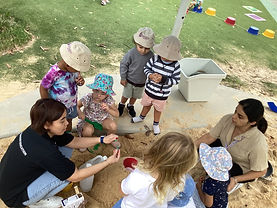
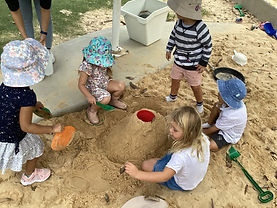

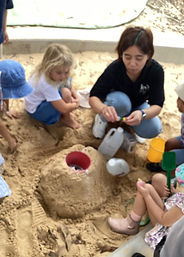

Story time with Miss. Lisna” Goldilocks with Three Bears”
Link to:
-
Link to:
-
National Quality Standards Q1 Educational Program and Practice
-
Australian Teaching Standards 2.3 Curriculum, assessment and reporting
-
Australian Teaching Standards 2.5 Literacy and numeracy strategies
-
Australian Teaching Standards 3.1 Establishing challenging learning goals
-
EYLF Learning Outcome 4. Children are confident and involved learners
-
EYLF Learning Outcome 5. Children are effective communicators
-
Play pedagogy: Modelled play
Journal and Reflection: Story Time with Miss Lisna - "Goldilocks and the Three Bears"
Journal Entry:
Our reading time with "Goldilocks and the Three Bears" was a fascinating experience for both children and me. As I read the story aloud, I noticed the children's eager reactions, their eyes bright with amazement as they followed Goldilocks' journeys across the forest. We explore deeper into the story using deliberate teaching and continuous shared thought, focusing on topics such as curiosity, consequences, and empathy.
As the narrative progressed, children actively participated, interpreting the characters' actions and giving their own experiences and viewpoints. It was amazing to see their interest and excitement as they anticipated each twist and turn in the plot. Storytime was a fantastic chance for co-construction, as we mutually discussed the storyline, characters, and moral of the story.
Reflection:
Story time with "Goldilocks and the Three Bears" provided a rich learning experience that was consistent with our pedagogical style of carefully structured play. By including storytelling into our curriculum, we developed an appreciation of books and language while also boosting children's confidence and involvement as learners. Through purposeful teaching and co-construction, we established a dynamic learning environment in which children felt empowered to express themselves, ask questions, and engage with challenging topics.
Moving further, we will build on the concepts and principles given in "Goldilocks and the Three Bears." One suggestion is to introduce children to other great fairy tales or folktales, enabling them to compare and contrast different storylines and characters. We may also add creative activities such as role-playing, puppetry, or prop-based storytelling to help them understand and appreciate storytelling traditions. To engage children in meaningful discussions and investigation during story time, I used continuous shared thinking, deliberate teaching, and co-construction.
We can cultivate a love of literature, fire imaginations, and encourage children's overall development by continuing to incorporate narrative and carefully structured play into our curriculum. Today's story time session marked only the beginning of our voyage of exploration and discovery through the realm of storytelling.
Where to Next?
Exploring Sequels or versions: Encourage children to investigate sequels or versions of the narrative, such as "Goldilocks and the Three Dinosaurs" or "Goldilocks Returns."
-
Encourage children to express themselves creatively through painting, drama, or role-playing, reenacting narrative scenarios or developing their own.
-
Literacy Extensions: Introduce related literacy tasks, such as sequencing events, recounting the narrative with puppets or props, or creating their own endings or other versions.
-
Incorporating STEM: Investigate the science of porridge cooking, construct bear-sized furniture, or build structures inspired by the story.
-
Link to teaching strategies: Use persistent shared thinking, purposeful teaching, and co-construction to engage children in meaningful discussions and learning experiences during storytime.
-
Link to EYLF Outcome #4: Encourage children to become confident and engaged learners by giving chances for active involvement, critical thinking, and reflection throughout story-related activities.
-
Link to the Australian Teaching Standards 2.1: Implement content and instructional practices that encourage literacy development, language acquisition, and social-emotional learning through carefully designed play and storytelling experiences.
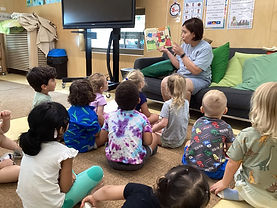


Experiment with Ms Lisna - Cloud/Rain Experiment
Link to:
-
National Quality Standards Q1 Educational Program and Practice
-
Australian Teaching Standards 2.1 Content and teaching strategies of the teaching area
-
Australian Teaching Standards 2.2 Content selection and organisation
-
Australian Teaching Standards 3.2 Plan, structure and sequence learning programs
-
EYLF Learning Outcome 4. Children are confident and involved learners
-
EYLF Learning Outcome 5. Children are effective communicators.
-
Teaching strategies: Sustained shared thinking, intentional teaching
Today, we conducted an amazing experiment with clouds and rain. With great anticipation, children and I gathered to learn about the water cycle and how clouds develop. We participated in a cloud-making project using simple materials, which we explored and observed firsthand. As we watched water vapour turn into clouds and rain, we stimulated the children's interest, amazement, and scientific enquiry.
Journal and Reflection: Experiment with Miss Lisna - Cloud/Rain Experiment
Journal Entry:
Today's experiment with clouds and rain was a fascinating exploration of nature's wonders. The children and I set off on a scientific enquiry of the water cycle, motivated by curiosity and a feeling of adventure. As we gathered our materials and prepared for the experiment, I could feel the children's excitement grow, anxious to witness the beauty of cloud formation firsthand.
With a clear objective and purpose, I conducted the experiment in a hands-on manner, allowing children to actively participate and engage in the process. We watched as water vapour rose from the warm water below and condensed on the plastic wrap, making our own clouds. The children's eyes glittered with awe as they watched the clouds develop and transform in front of them.
As the experiment went on, we introduced the concept of rain by gently pressing on the plastic wrap, causing droplets to fall from the clouds below. The children's excitement was evident as they felt the rain and connected it to the natural processes that occur in the environment.
Reflection:
The cloud/rain experiment offered a rich and immersive learning experience, encouraging children's curiosity, enquiry, and scientific understanding. We investigated the secrets of cloud formation and precipitation cooperatively, using persistent shared thinking, deliberate teaching, and co-construction, strengthening our respect for the natural world's interconnection.
As an educator, I saw the children's confidence and involvement as active learners, participating in conversations, making predictions, and connecting the experiment to their prior knowledge. The experiment acted as a spark for meaningful learning, inspiring children to become interested in science and discovery.
Where to Next?
Further Exploration of the Water Cycle: Learn more about the water cycle's components, including evaporation, condensation, and precipitation.
-
Weather Investigations: Extend your knowledge by researching different weather phenomena such as wind, thunderstorms, and snow.
-
Encourage children to express their understanding of clouds and rain via artistic activities like painting or drawing.
-
Outdoor Exploration: Take your lessons outside to view real clouds and weather patterns in the sky, bridging theoretical concepts with real-world observations.
-
Link to Teaching Strategies: Use shared thinking, purposeful teaching, and co-construction to facilitate children's discovery and learning throughout experiments.
-
Link to EYLF Outcome 4: Provide chances for active participation, critical thinking, and reflection during scientific studies to help children develop confidence and engagement.
-
Australian Teaching Standards 2.1 recommend using play and experimentation to foster scientific understanding and enquiry.
